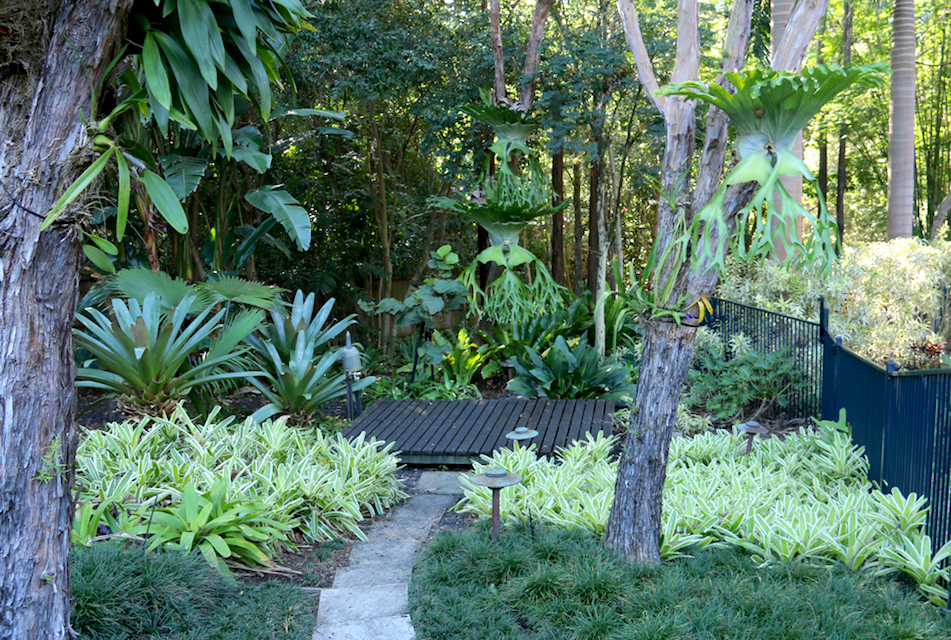Does an Australian garden style exist? In the post WW11 years some of our now most revered garden designers rebelled against imported garden design traditions and experimented with creating a nature based Australian style. Dr Anne Vale explores what the “Australia” style garden looks like.
Ellis Stones and Gordon Ford from Victoria and Jean and Betty Maloney from NSW created unique interpretations of an Australian Style garden replicating the Australian landscape by utilizing rocks, water and the Australian bush.
We also had a ‘grow native’ fashion faze through the 1970s and 1980s. Promoted as low maintenance these Australian style gardens frequently resulted in overgrown, woody, short lived shrubberies combined with majestic gums which dominated suburban gardens. They made it almost impossible to plant anything new and caused much angst when eucalypt limbs dropped onto houses, cars and even people.
Fast forward three decades and it is quite a different story. For starters Australian style gardens are being created in every State not just Victoria and Southern NSW. Contemporary Australian designers have also championed the concept of the outdoor kitchen/entertainment space which some may argue are often not gardens at all as they frequently lack any significant planting.

Andrew Laidlaw designed the wonderful Children’s Garden at Melbourne’s Royal Botanic Garden. Photo Jasmine Fairhurst
This very recognizable Australian style is recreationally driven. It features swimming pools, BBQs, pavilions, outdoor televisions, outdoor kitchens trampolines and playgrounds. The whole concept is based on the blurring of the boundaries between inside and outside. Typically we use timber decking and natural materials whereas in England and Europe they would use stone as the basis for their garden structures. There is an emphasis on natural colours to blend with Australian plants or landscape. It is a style that acknowledges that Australians spend a lot of time outside, alfresco living, dining out doors.
We have seen some very upmarket examples of Australian landscape design on the current ‘Dream Gardens‘ show on ABC TV. Michael McCoy does a brilliant job of hosting this series. He is a natural in front of the camera and his design and plant knowledge is second to none. However, it is rather disconcerting to find that so many of the owners of these designed spaces are not interested in gardening at all!
Travelling across Australia to conduct interviews for Influential Australia Garden People: their stories I quickly came to the conclusion that designing gardens specifically for local conditions and local architecture was now entrenched thinking. The one thing that people agreed upon was that talk about a universal Australian style was just nonsense. Our country is too big, with extremes of climatic zones, topography and lifestyles. Many felt annoyed with popular media for constantly referring to ‘Australian style’ or plants that did well in ‘Australian conditions’ as if one size fitted all.
As Queensland landscape architect Arno King puts it,
“The north is so different from the south, the centre from the west and by trying to create something that is representative we don’t celebrate the local or the individual. It just becomes this dirge and I think that has been killing our designers here. If we would celebrate our top designers and celebrate the local we would be like England or New Zealand or other countries that don’t have ‘The Australian Cringe’.”
Localised Australian styles do make a lot more sense, if we consider the style of Philip Johnson, Fiona Brockhoff or Kate Cullity there is clearly Australian context to their gardens and they are also ‘of their place’. They are all vastly different from each other but they have a recognizable Australian style. The Australian garden in Cranbourne reflects the Kimberly’s and the Pindan. Philip Johnson’s style is all about billabongs, waterfalls, rocks, native plants and habitats and Fiona Brockhoff is known for her sculpted native plants and a bleached look that is perfect for the Mornington Peninsula in Victoria.
There are other Australian style gardens too. Myles Baldwin and Michael Bligh create gardens around heritage homes and they produce a particular Australian aesthetic. As Myles puts it;
“who does the best Victorian gardens in the world? Australia does. The Victorian garden consists of a collection of plants from across the globe; they can be seen at their best in the colonies where they don’t have to be cosseted away in a glass house. We created these amazing Victorian era botanic gardens with a great diversity of plants because we had the right climate in those places.”
A perfect example is the garden that Myles worked in for many years at Bronte in NSW. Here he created a Victorian garden with rich colour schemes and a vastly different collection of plants and eclectic areas with various zones for specialized plants.
Michael Bligh has made a name for himself on large rural properties in NSW by creating a colonial Australian aesthetic which incorporates the borrowed view of eucalypt clad hills and contented cattle grazing in the paddock.
There is no doubt that our connectivity to global trends has also shaped the ideas of this generation. We are no longer an isolated backwater. Through the internet, Pinterest and Instagram our designers can instantly see the latest ideas from overseas which creates a globalization of the Australian aesthetic. This is reflected in the attitude of all the designers that ‘it has to be ‘the right plant for the right place.’ There may be a preference for an Australian plant, if a nature style garden is being created, but on the whole designers are more interested in selecting plant material that is functional and sustainable. The planting plan has to be appropriate for the built landscape that it invariably accompanies. Many of our designers were not at all interested in being pigeon holed into having a particular personal design style. Their emphasis is on using the genius of the site, working with plants that are appropriate for the client and making something that is uniquely different.

Michael Bligh design – a flower-filled garden with views of eucalypt-clad hills beyond. Photo Kim Woods Rabbidge
There was universal condemnation for highly paved, mono culture gardens of the like planted by developers in urban infill growth corridors and by some new home owners. Plastic grass, impermeable surfaces and glass mulch was viewed with great alarm especially in arid, drought prone regions. The consensus was that we need to get young parents with young children to plant real gardens. We need green space with a variety of plant material to attract micro organisms, layers of plant material including shady trees and places for birds to perch.
Designers were keen to point out that sustainability for them is about designing landscapes that last a long time. Edna Walling’s name came up time after time as a perfect example of good design with lovely trees and hard landscapes that utilized local materials.
About
Dr Anne Vale is an author, historian, lecturer and garden photographer. Anne is the author of award winning Exceptional Australian Garden Makers (2014). The sequel, Influential Australian Garden People, which follows the influences of the next generation, is due to be published late 2016. Anne records and assesses gardens with history through her consulting practice Heriscapes.



























I love the garden idea. I did a modified garden bedroom for myself. My walls are a soft green and I used an antique-look bedspread and shams.